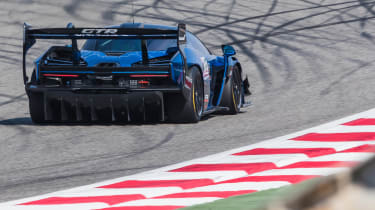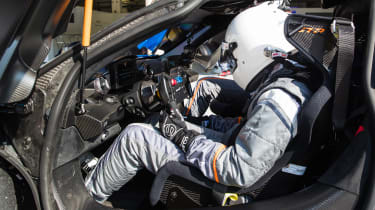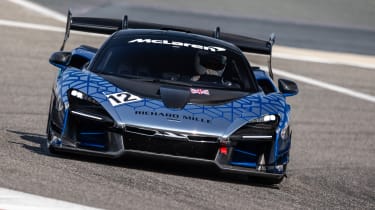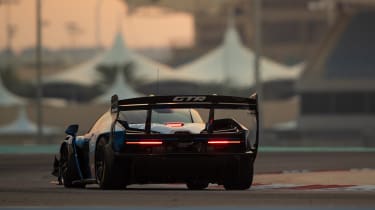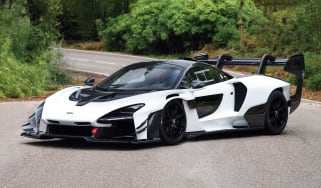McLaren Senna GTR review – worth £500k more than the road car?
The track-only Senna GTR will set you back over half a million pounds more than the cost of a Senna road car. So, is it worth it?
Track-only supercars need rebranding. They’re amongst the wildest, most outrageous and most technologically advanced cars ever built. They pay no heed to humdrum considerations such as pedestrian safety laws, nor do they adhere to restrictive motorsport regulations. They use the most exotic materials, the most innovative moveable aerodynamic devices and their power outputs and performance potential dwarfs that of most high-end factory GT race cars. This is Can-Am played out by the likes of Ferrari, McLaren and Aston Martin. These are the Group B hypercars. The difference is they’re available not just to the world’s elite drivers. Real-life customers can buy and experience these no-rules monsters.
McLaren’s take on this rarefied breed is the Senna GTR. And it has 172bhp, erm, less than its predecessor, the brilliantly bonkers P1 GTR. In fact, with ‘just’ 814bhp from its 4-litre twin-turbocharged V8 it’s only 25bhp up on the Senna road car. And whilst it now produces a full 1000kg of downforce at 155mph, that’s only 200kg – or 25 per cent – more than a Senna with number plates and the freedom of the entire world to drive in. Surely ‘no limits’ should be madder than an extra 25bhp and 25 per cent more downforce on just a few corners around the world? Remember, you’re not doing 155mph on that many corners on racetracks globally. Now factor in the price of £1.1million plus local taxes and the Senna GTR appears to be teetering on the edge of credibility.
More reviews
> McLaren 750S 2024 review – V8 supercar primed to take on Ferrari’s 296 GTB
Of course, such rational arguments are easy to make when you’re perusing a press release. See a Senna GTR resting in a pit garage on its air jacks, huge rear wing reaching up to the sky, top-exit exhausts poking way beyond the bodywork to better dissipate the heat, and a fat slick lying at each corner ready to be fitted, and your view very quickly softens. It looks sensationally silly and there’s so much aero thrown at the basic shape that it hardly looks like a Senna at all. Which, depending on your point of view, is either a very good thing or, well, an even better thing. The awkwardness is gone, to be replaced with a part sci-fi, part fantasy VLN racer look.
So it’s not crazily more powerful than the road car. That’s understandable considering we live in times when road cars are often miles more powerful than their race car cousins. The point is the Senna GTR is a car with 814bhp and 590lb ft and weighing 1188kg dry. It produces equivalent downforce to the road car at 15 per cent lower speeds and then has that aforementioned much higher peak figure, too. Braking performance is much improved by the adoption of a new pad material, different fluid and a new brake booster but, interestingly, it still has the same carbon-ceramic discs and calipers as on the road car. And hiding under all that aerodynamic furniture is a radically different suspension set-up that shares much with the 720S GT3 racer. This is not a rational car. No track-only hypercar is. But all 75 have been sold. In fact, in the garages next door are three more GTRs.
The intimidation is always high when you scrunch yourself up to back through a roll-cage and into a deeply sculpted race seat, but the GTR’s driving environment is just as comfortable and precise as you’d expect of a McLaren and the forward visibility is fantastic. The GTR has a rear-view camera system with radar that colour codes cars as they approach or recede in your ‘mirrors’. I’ll almost have the track to myself so won’t need to worry too much about that, but it’s a cool feature and I remember it worked brilliantly when I raced the Glickenhaus SCG 003. The steering wheel is pure racer, too. Lifted from the 720S GT3, it’s tiny, with two grips, dials for ESC and powertrain modes (Wet, Track and Race), and rows of buttons just a thumb’s reach away marked with things such as DRS, Launch and Talk.
There’s no adjustment for the suspension because instead of McLaren’s RaceActive Chassis Control II system, which links dampers hydraulically to not only adjust damping force but also manipulate roll stiffness, the GTR uses good old-fashioned four-way adjustable Öhlins dampers and anti-roll bars front and rear. It seems strange that McLaren has abandoned the system it makes such strong claims about elsewhere, but it’ll quietly admit the new set-up makes for a more ‘natural’-feeling car. Without the bandwidth required of a road-going Senna, the stability and fine-tuning possible with a more analogue system is the best solution. Plus, there’s no doubt owners will get to play with the set-up as part of their wider driver education that so many sign up to via McLaren’s ‘Pure’ driving events. And who doesn’t like to say things such as ‘I think we should soften off the rear bar and tweak the high-speed damping’ and pretend to know what that might actually do?
Prod the roof-mounted starter button and the V8 wakes up without so much as a flare of revs. The noise is plain. Ugly even. There’s none of the intrigue of the P1 GTR’s hybrid powertrain, which whirs and chirps and then chuffs and snorts when the turbos start working. In fact it’s relatively quiet even when the GTR has rolled along the pitlane, crossed the line that marks the end of the 60kph zone and I’ve tentatively rolled into the throttle. I’m linked up via radio to racing driver Tim Sugden in the passenger seat, who’s here to help me around the track and to stop me spinning the GTR into the middle of next week, but I don’t have to raise my voice even a little to communicate clearly. If the GTR is to serve up real drama it won’t be from a living, breathing monster of an engine.
Does it feel fast? Well… yes. Over 800bhp in less than 1200kg is a vivid experience. However, after the P1 GTR – a relevant comparison because owners are jumping from one to the other in many cases – it’s not especially outrageous. There’s none of the free-fall sensation that the older car delivers thanks to its electrically augmented delivery, and because the Senna GTR’s traction is so much better it feels very much within itself. I’d liken it to a GT3 car that breathes much better at the top end rather than a hypercar with the wick turned up beyond the realms of sanity. The wide expanses and long straights of Bahrain clearly sap some of the madness (it’d probably feel pretty lively at Cadwell!) and also highlight just how draggy the GTR is. It gets going alright, but over 160mph or so you can feel that you’re towing a substantial carbonfibre structure behind you.
The Senna GTR, of course, is all about the corners and the aero. It has a much bigger front splitter and dive planes, the rear diffuser is massive compared to the road car’s and that rear wing has been moved further rearwards in order to couple more effectively with it. The additional side supports for the monumental wing aren’t load-bearing but instead smooth the airflow down the sides of the car. As with the road car the GTR features active aerodynamics, with two flaps either side of the front radiators that can be opened to stall the wing, which itself is articulated and moves continuously to help maintain aero balance, shorten braking distances and reduce drag. As mentioned before, there’s a DRS button… which you will forget to use and doesn’t appear to make a massive difference anyway.
You won’t care at all. Because the straights really are just the boring bits in the Senna GTR. The first few laps you simply marvel at the brakes. They may share hardware with the road car system, but they feel pure racer. Stopping distances are incredibly short, the pedal is absolutely consistent (much more so than in the road car) and yet the car feels so planted under deceleration. You can drive right into the turns on the brakes with little fear of the tail whipping around and to do so kills any chance of understeer building up. The key to unlocking the GTR’s full potential is to get it into the apex using this stability, wait just a shade longer than instinct tells you is right so the car is fully rotated and then open the steering and get into the throttle nice and hard. It’s not the on-the-edge dance of something simple and reliant solely on mechanical grip such as a Caterham, but this particular technique has its own rewards.
It’s a fascinating challenge and in time you learn the sort of kerbs you can sail over and which ones to avoid so as not to detach the aero and lose stability. For me, the faster corners are harder to adjust to because the steering response is so strong as the aero load starts to build up and you have to keep slowing down your inputs to make the car flow rather than take several bites out of each turn. In time though, you can start to feel like you are hustling the car rather than just paddling around well within it limits. Eventually it’ll slip into understeer mid-corner and you can lean on the traction control out of turns to exit with just a little bit of angle, too. It really is remarkably friendly for a car with such huge reserves of grip and power.
So the Senna GTR has shifted in philosophy from the wild P1 GTR. It’s easier to drive, is much more stable at the rear and has a pure racer feel. I’m sure it sets much quicker lap times, too. McLaren says it’s significantly quicker than a GT3 car but won’t commit to any specific lap times, which seems odd for a track car that’s marketed as McLaren’s fastest outside of F1. I guess the bigger question is should our newly christened Group B no-rules hypercar feel like a faster GT3 car or something completely of itself: faster, more manic, maybe a little bit less concerned with chasing lap times and more about the experience of taming something fully unleashed? It seems ridiculous to suggest making a car that’s less controlled, less cohesive, but I can’t help feeling the Senna GTR could do with a bit more blood and thunder.
Let’s say I’m wrong. It has been known! Maybe a no-rules hypercar should be a GT3 or GTE car on steroids. If that’s the case then I still think the Senna GTR needs a little work. For example, it retains the seven-speed dual-clutch ’box of the road car instead of going for a full-on sequential race ’box. Maybe that’s a practical decision based on rebuild requirements and durability, and the shifts are undoubtedly fast and impressive. But they’re not as exciting as with a full-on race ’box. Plus the Senna GTR relies on the road car Brake Steer system instead of a mechanical locking differential, and the traction control and ABS is road car derived rather than the simply amazing and fully adjustable system you get with a full Bosch motorsport set-up. All of which you’d get on a 720S GT3, which costs £440,000 plus taxes.
Of course, I’m being slightly harsh and holding the Senna GTR to the highest of standards. However, given the cost, that seems reasonable. Driving it at Bahrain has been huge fun and a real thrill. It’s the sort of thing you dream of doing and I’m sure you could learn a massive amount doing a season or two of these Pure events with the aid of driver coaching, video and data analysis and lots and lots of track time. And ‘value’ is a slightly alien concept when you get up into this rarefied air. However, cast your eyes around to GT3 racers, LMP2 cars, maybe even the track-only Ford GT Mark II and its Le Mans-winning heritage and you can’t help wonder if the Senna GTR is the biggest thrill you can buy for an awful lot of money. A brilliant car, then. But not something we’ll remember decades from now in hushed tones like Can-Am and Group B.
McLaren Senna GTR specs
| Engine | V8, 3994cc, twin-turbo |
| Power | 814bhp @ 7250rpm |
| Torque | 590lb ft @ 5500rpm |
| Weight (dry) | 1188kg (696bhp/ton) |
| 0-62mph | 2.8sec (est) |
| Top speed | 195mph (est) |
| Basic price | £1.1million plus taxes |
This story first featured in evo issue 270.


